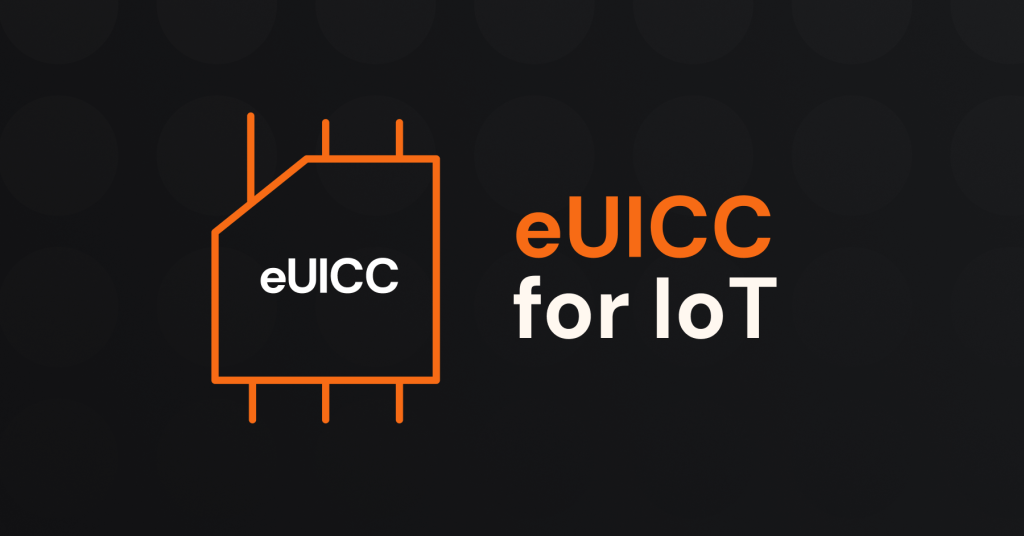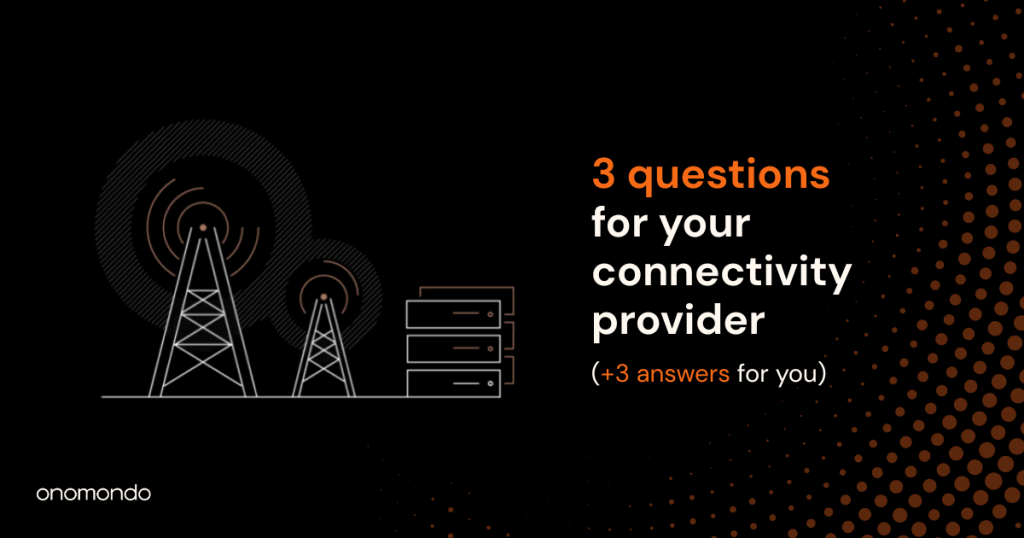You have probably seen IoT eSIMs advertised as a game-changing solution for global IoT device connectivity.
They have opened up new possibilities for IoT solution providers, making it easier to develop devices for global markets thanks to the ability to switch carrier profiles.
But are they as future-proofed and innovative as advertised?
In this article, we explore the facts about eSIMs and their alternatives.
Table of Contents
What is an eSIM?
To understand eSIM, we first need to look at the “traditional” alternative.
Traditional SIMs are carrier-specific and only have one profile (e.g., Vodafone, T-Mobile, or Three). Therefore, if you want to change carriers to access different prices, new technologies, or new markets, you also have to replace the SIM.
eSIMs were introduced to take away the pain of one-profile SIM cards.
At its core, eSIM is a way to remotely provision carrier profiles on IoT devices. As a result, there’s no need to manually swap SIMs when changing carriers, something that would be incredibly impractical for IoT devices deployed at scale, globally.
However, it’s important to understand that people use the term eSIM to describe two related but separate concepts in the industry.
- Embedded SIM form factor: eSIM means embedded SIM, a non-removable SIM card form factor that can be mounted (soldered) directly onto the surface of a circuit board.
- eUICC software on SIMs: eSIM is also used to describe the eUICC (Embedded Universal Integrated Circuit Card) architecture that allows a SIM to have multiple network profiles.
While GSMA defines eSIM as the eUICC architecture, it’s often bundled with the embedded SIM chip when marketed to the IoT industry.
Unfortunately, these two concepts are often conflated. However, the SIM chip form factor (hardware) and eUICC architecture (software) are independent properties when selecting your IoT connectivity.
Understanding SIM form factors.
Stepping back and looking at the bigger SIM picture, you could say the differences between SIMs start with the form factor.
Just as with computers and smartphones, SIM cards come in various shapes and sizes, and these form factors don’t necessarily determine what kind of software the SIM will have implemented.

SIM form factors:
- Full-Size (FF1)
- Mini-SIM (FF2)
- Micro-SIM (FF3)
- Nano-SIM (FF4)
- Embedded SIM, aka eSIM (MFF2)
- iSIM
- SoftSIM
The FF1 SIM card is the oldest and also the biggest. Over the years, the size of SIM cards has gone down, which comes with obvious hardware benefits – such as extra space.
Soldered eSIMs have become broadly popular, iSIMs is a recently developed system on a chip that is installed alongside the modem and processor, and SoftSIM is a 100% software SIM installed on hardware already existing in devices.
Architecture standards:
- ICC
- UICC
- eUICC
The ICC standard is long outdated and generally out of use. It can only use GSM and 2G, so you’re unlikely to come across it when choosing SIM cards for your IoT system. More on eUICC and UICC next.
UICC and eSIM (eUICC).
Now, let’s dig deeper into UICC and eUICC to understand how the solutions can help IoT.
UICC vs. eUICC
UICC (universal integrated circuit card) is the most widely used SIM software standard as it supports GSM/2G, 3G, 4G, 5G, LTE Cat 1 bis, and LTE-M and NB-IoT.
However, UICC cards can only hold one operator profile, making them prone to issues with permanent roaming and achieving broad global coverage.
That’s where eUICC comes in.
eUICC is software on the SIM card that allows for the remote provisioning of carrier profiles. So it’s like having a card made of multiple UICC SIMs, with the eSIM platform managing which one is active.
It’s like having a card made of multiple UICC SIMs, with the eSIM platform managing which one is active.
eUICC can be used on all SIM form factors (2FF to MFF2 embedded SIMs), but having an embedded SIM (eSIM) doesn’t guarantee that you have eUICC, and vice versa.
An eSIM management platform manages the carrier profiles on the devices over the air (OTA) without physically changing the SIM hardware on the device. The eSIM platform is one of the reasons why the IoT marketing material has often combined the MFF2 chip with the eUICC software because you don’t want to solder something onto your device which you can’t change over the air.
Here’s a basic illustration of the architecture that makes up UICC and eUICC software:

Key eUICC components:
- The ISD-R (Issuer Security Domain Root) is the on-card representative of the SM-SR (Subscription Manager Secure Routing in the core network) that manages SIM profiles, among other functions.
- ISD-P1 … ISD-PN are the UICC profiles and the on-card representative of the operator, or SM-DP (Subscription Manager Data Preparation).
- The ECASD (eUICC Controlling Authority Security Domain) is created within an eUICC during manufacture and cannot be deleted or updated.
eUICC pro: Avoiding permanent roaming issues.
Permanent Roaming is a hurdle IoT solution providers need to overcome when taking their products global.
For example, in Brazil and Turkey, permanent roaming is entirely off-limits to international providers.
A solution is an applet on eUICC that switches networks. The SIM can then rotate around, e.g., four networks avoiding permanent roaming restrictions by changing the required amount within a year.
eUICC con: Limited number of profiles.
Because the storage space on eUICC SIMs is limited, you can generally only have four or five profiles on an eUICC SIM at one time. Of course, you can update profiles on eUICC, but this is a data and power-consuming task.
This profile limit becomes an issue if you have devices that move around or are unsure where they will end up after manufacture.
eUICC con: Data and power consumption.
eSIM consumes relatively more power than managing network routing in the Core Network (how Onomondo manages global connectivity, more on that later).
Profile switching uses a lot of data and, therefore, power. The processing around profile switching happens on the SIM. ISD-R has to manage the profiles (the separate ISD-Ps) in the eUICC, and there’s authentication that needs to occur with switching.
To give you a better idea of why this increases data and power consumption, here’s part of what happens when you update profiles on eUICC according to GSMA (Remote Provisioning Architecture for Embedded UICC Technical Specification Version 4.2):

eUICC con: Lock-ins.
There are two kinds of lock-ins with eUICC, technical and commercial lock-ins.
Technical lock-ins are unavoidable when using eUICC.
eUICC SIMs require a record (ECASD). This record contains information like the IP address of the eSIM platform, granting it access to that platform.
This record, however, cannot be changed once implemented.
So your eUICC SIM will be locked to its initial management platform – you are locked into that platform’s features, or lack thereof, for as long as you’re using the SIM.
For example, say that you come across a platform that offers better features than your current one, and you decide you want to switch to it. The only way to do so is by physically swapping out the SIMs of all of your IoT devices. The larger your deployment, the more difficult this is going to be.
The second kind of lock-in is a commercial lock-in.
A commercial lock-in is where your connectivity provider requires you to maintain a bootstrap network profile on your SIMs, forcing you to pay connection costs even when you aren’t using the profile or hindering you from switching it after initial deployment.
Bootstrap profiles allow your device to connect to any network available without needing to be established. They’re generally only meant to be used when first setting up your device or as a global backup profile if your device moves out of the coverage area of the active profile, allowing you to set the device up without having to connect to WIFI or a network before interacting with the device.
However, when you are commercially locked in, the cost of a bootstrap profile can needlessly increase your overhead, especially in large-scale IoT projects.
Onomondo SIMs.
Many operators have gone down the eSIM (eUICC) route to offer customers global coverage on one SIM and avoid permanent roaming issues.
We’ve taken a different path.
Instead of placing switching logic on the SIM (e.g., eUICC), we’ve taken the burden off devices and put network routing in the core network.
We can do this because, unlike any other MVNO, Onomondo has built full-core integrations with every single MNO in our 680+ networks.

Our global IoT SIMs have global connectivity with one profile and one APN. We’ve integrated all RANs into our Core Network. So if you use an Onomondo SIM in the US with Verizon, China with China Unicom, or Denmark with Telia, everything goes through our Core Network. We call this network agnostic.
Having one network means, among other things, that you don’t have to worry about forecasting regional usage for devices and that you can have insights and access to monitor all devices – globally and in real-time.
Our approach doesn’t mean that our single, global profile only works on UICC; Onomondo can also be added to eUICC to create an out-of-the-box 700+ network eSIM.
Is UICC or eUICC best for your IoT project?
You can implement UICC and eUICC on all SIM form factors. So you have a lot of flexibility when deciding between the two.
It’s important to remember that while eUICC is newer than UICC, the only real advantage it has is multiple carrier profiles on one device and switching between them in, which helps skirt some strict permanent roaming restrictions. But with that advantage comes the complication of lock-ins.
However, you can also achieve global connectivity to over 700 local networks with Onomondo on UICC SIMs.
Opting for connectivity with Onomondo, whether on UICC or eUICC software and 4FF (nano-SIM) or MFF2 (embedded SIM) form factors, means you don’t have any hidden lock-ins or costs, keeping your IoT future-proofed in the changing market of IoT.
By building a global network specifically for the IoT industry, with the specific mindset to limit the complexities of managing large-scale and international IoT deployments, Onomondo is reducing the burden of managing commercial agreements with many network providers.
This one network covers 180+ countries, most with two or more networks per country and permanent roaming. As a result, many businesses that would have to use eUICC could solely use Onomondo’s global network.







